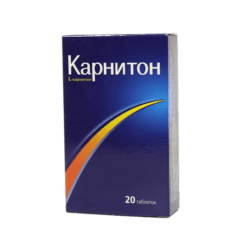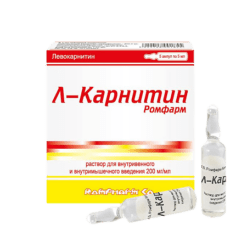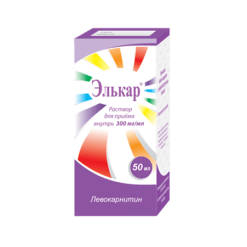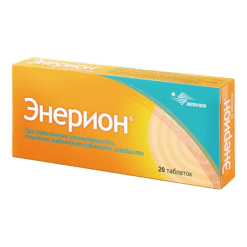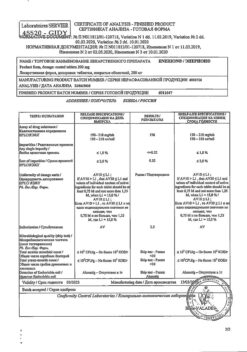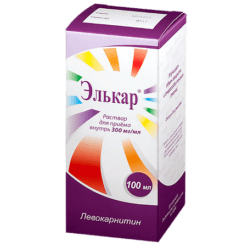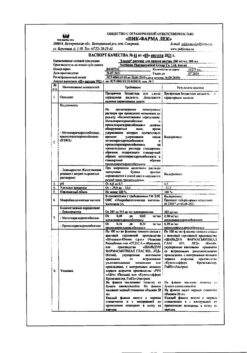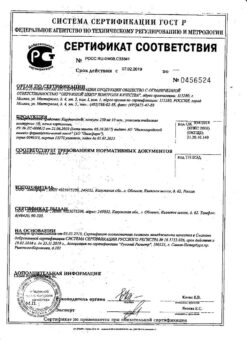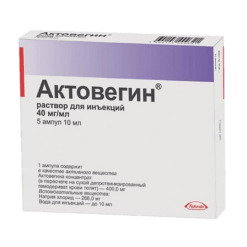No products in the cart.
Orsoten Slim, 60 mg capsules 84 pcs
€47.91 €39.92
Description
Pharmacodynamics
Orlistat is a specific, long-acting inhibitor of gastrointestinal lipases. Its therapeutic activity is realized in the lumen of the stomach and small intestine and consists in the formation of a covalent bond with the active serine site of gastric and pancreatic lipases.
The enzyme thus inactivated loses its ability to hydrolyze dietary fat in the form of triglycerides to absorbable free fatty acids and monoglycerides. Undigested triglycerides are not absorbed and the resulting caloric deficit can have a positive effect on body weight control.
Orlistat at a dose of 60 mg three times daily blocks the absorption of approximately 25% of dietary fat. The therapeutic effect of orlistat is realized without its systemic absorption. The effect of orlistat causes the concentration of fat in the intestinal contents to increase 24-48 hours after oral administration. After discontinuation of orlistat, intestinal fat concentration usually returns to baseline in 48-72 hours.
In adults with a BMI (body mass index) ≥ 28 kg/m2, orlistat at a dose of 60 mg three times daily is effective in combination with a low-fat, hypocaloric diet. At the same time, the main weight loss occurs during the first 6 months of treatment.
The weight loss seen with orlistat at a dose of 60 mg three times daily is accompanied by other beneficial effects: decreased total cholesterol, LDL (low-density lipoprotein) cholesterol, and decreased waist circumference.
Pharmacokinetics
Absorption
Studies in normal and overweight volunteers have shown that the degree of absorption of orlistat is minimal. The plasma concentration of unchanged orlistat is below the limit of quantification (below 5 ng/ml) 8 h after oral administration of orlistat at a dose of 360 mg. In general, with therapeutic doses, the determination of unchanged orlistat in plasma is sporadic and its concentration is extremely low (less than 10 ng/mL or 0.02 μmol/L), with no evidence of cumulation, indicating minimal absorption.
Distribution
The amount of distribution cannot be determined because orlistat is minimally absorbed and has no established systemic pharmacokinetics. Orlistat is more than 99% bound to plasma proteins (mainly lipoproteins and albumin). Orlistat can minimally penetrate into erythrocytes.
Metabolism
The metabolism of orlistat occurs mainly in the walls of the stomach and small intestine.
Excretion
Approximately 97% of the dose is excreted through the intestine, 83% of this amount as unchanged orlistat. Cumulative renal excretion of all orlistat-containing substances is less than 2% of the administered dose. The time to reach complete excretion (through the intestine and the kidneys) is 3 to 5 days.
Indications
Indications
Weight loss in adults (over 18 years of age) with excess body weight (body mass index BMI ≥ 28 kg/m2). Use only in combination with a moderate hypocaloric diet with low fat content.
Pharmacological effect
Pharmacological effect
Pharmacodynamics
Orlistat is a specific, long-acting inhibitor of gastrointestinal lipases. Its therapeutic activity is realized in the lumen of the stomach and small intestine and consists in the formation of a covalent bond with the active serine site of gastric and pancreatic lipases.
Inactivated in this way, the enzyme loses its ability to hydrolyze dietary fat in the form of triglycerides into absorbable free fatty acids and monoglycerides. Undigested triglycerides are not absorbed, and the resulting caloric deficit may have a positive effect on weight control.
Orlistat 60 mg three times daily blocks the absorption of approximately 25% of dietary fat. The therapeutic effect of orlistat is realized without its systemic absorption. The effect of orlistat leads to the fact that the concentration of fat in the intestinal contents increases within 24–48 hours after its oral administration. After discontinuation of orlistat, the concentration of fat in the intestinal contents usually returns to baseline levels within 48–72 hours.
In adults with a BMI (body mass index) ≥ 28 kg/m2, orlistat 60 mg three times daily is effective in combination with a hypocaloric, low-fat diet. In this case, the main loss of body weight occurs during the first 6 months of treatment.
Weight loss associated with the use of orlistat at a dose of 60 mg three times a day is accompanied by other beneficial effects: a decrease in the concentration of total cholesterol, LDL cholesterol (low-density lipoproteins), and a decrease in waist circumference.
Pharmacokinetics
Suction
Studies in volunteers with normal and increased body weight have shown that the extent of absorption of orlistat is minimal. The plasma concentration of unchanged orlistat is below the limit of quantitation (below 5 ng/ml) 8 hours after oral administration of orlistat 360 mg. In general, when therapeutic doses are used, the determination of unchanged orlistat in blood plasma is sporadic, and its concentration is extremely low (less than 10 ng/ml or 0.02 μmol/l), and there are no signs of accumulation, which indicates a minimal degree of absorption.
Distribution
The volume of distribution cannot be determined because orlistat is minimally absorbed and has no established systemic pharmacokinetics. Orlistat is more than 99% bound to plasma proteins (mainly lipoproteins and albumins). Orlistat can penetrate into red blood cells to a minimal extent.
Metabolism
Metabolism of orlistat occurs mainly in the walls of the stomach and small intestine.
Removal
Approximately 97% of the dose is excreted through the intestines, 83% of this amount is excreted as unchanged orlistat. Cumulative renal excretion of all orlistat-containing substances is less than 2% of the administered dose. The time to achieve complete excretion (through the intestines and kidneys) ranges from 3 to 5 days.
Special instructions
Special instructions
Patients should be instructed to adhere to the dietary recommendations they receive. The likelihood of side effects from the gastrointestinal tract is higher if a particular meal or diet as a whole is characterized by a high fat content.
Treatment with Orsoten® slim may impair the absorption of fat-soluble vitamins (A, D, E and K). For this reason, multivitamins should be taken before bed.
Since weight loss may be accompanied by improved metabolic control in patients with diabetes mellitus, those receiving hypoglycemic drugs should consult a doctor before using Orsoten® Slim and, if necessary, adjust the dose of hypoglycemic drugs.
Weight loss may be accompanied by an improvement in blood pressure and a decrease in cholesterol concentrations.
Patients taking medications for hypertension or hypercholesterolemia should consult a doctor when using Orsoten® Slim and, if necessary, adjust the dose of these medications. Patients taking amiodarone should consult their doctor before starting therapy with Orsoten® slim.
Cases of rectal bleeding have been reported in patients using orlistat. If this phenomenon occurs, the patient should consult a doctor.
The use of an additional method of contraception is recommended to prevent possible oral contraceptive failure if severe diarrhea occurs.
Impact on the ability to drive vehicles and other mechanisms that require increased concentration
The drug Orsoten® slim does not affect driving or operating technical devices that require increased concentration and speed of psychomotor reactions.
Active ingredient
Active ingredient
Orlistat
Composition
Composition
Active ingredient:
orsoten semi-finished product – granules – 112.8 mg, in terms of orlistat – 60 mg (auxiliary substance of the semi-finished product – microcrystalline cellulose granules).
Excipients:
microcrystalline cellulose – 22.20 mg.
Hard gelatin capsules No. 3:
Capsule body:
titanium dioxide (E 171) – 0.58 mg,
gelatin – 28.22 mg.
Capsule cap:
titanium dioxide (E 171) – 0.19 mg,
iron oxide yellow (E172) – 0.04 mg,
gelatin – 18.97 mg.
Pregnancy
Pregnancy
There are no clinical data on the use of orlistat during pregnancy, therefore Orsoten® slim should not be used during pregnancy.
Since it is unknown whether orlistat is excreted in breast milk, Orsoten® slim should not be used during breastfeeding.
Contraindications
Contraindications
Hypersensitivity to orlistat or to any of the components of the drug;
glucose-galactose malabsorption syndrome;
cholestasis;
concomitant therapy with cyclosporine;
pregnancy, breastfeeding period;
age up to 18 years.
Side Effects
Side Effects
Classification of the frequency of side effects (WHO):
very often > 1/10;
often from > 1/100 to < 1/10;
infrequently from > 1/1000 to < 1/100;
rarely from > 1/10000 to < 1/1000 very rarely from < 1/10000, including isolated reports.
Adverse reactions when using orlistat are usually gastrointestinal in nature and are associated with its pharmacological action.
From the digestive system: very often – oily discharge from the rectum, release of gases with some discharge, imperative urge to defecate, steatorrhea; often – abdominal pain, fecal incontinence, loose stools, increased bowel movements.
During post-marketing use of orlistat, the following adverse reactions were observed (frequency unknown):
From the hematopoietic system: decreased concentration of prothrombin; an increase in the International Normalized Ratio (INR) in patients taking orlistat concomitantly with anticoagulants.
From the digestive system: slight rectal bleeding, diverticulitis, hepatitis, cholelithiasis, increased activity of “liver” transaminases and alkaline phosphatase.
From the skin: bullous rash.
Allergic reactions: itching, rash, urticaria, angioedema, bronchospasm, anaphylaxis.
Interaction
Interaction
Cyclosporine
With the simultaneous use of cyclosporine and orlistat, a decrease in the concentration of cyclosporine in the blood plasma is observed, which may be accompanied by a decrease in its immunosuppressive activity.
The simultaneous use of orsoten and cyclosporine is contraindicated.
Oral anticoagulants
With the simultaneous use of warfarin or other oral anticoagulants and orlistat, a change in the International Normalized Ratio (INR) may occur.
Fat-soluble vitamins
The use of orlistat may impair the absorption of fat-soluble vitamins (A, D, E and K).
Acarbose
Due to the lack of data on pharmacokinetic interactions, it is not recommended to use orlistat concomitantly with acarbose.
Amiodarone
When used simultaneously with orlistat, a decrease in the concentration of amiodarone in the blood plasma was observed after a single use. The clinical significance of this effect in patients taking amiodarone is unclear. The simultaneous use of orlistat and amiodarone is possible only on the recommendation of a doctor.
Orlistat does not interact with amitriptyline, phenytoin, fluoxetine, sibutramine, phentermine; atorvastatin, pravastatin, fibrates; biguanides; digoxin, nifedipine, losartan; oral contraceptives and ethanol.
Overdose
Overdose
Symptoms: when using orlistat at a dose of 800 mg once and at a dose of up to 400 mg three times a day, daily, for 15 days, no significant adverse reactions were detected in both patients with normal body weight and in obese patients. When using orlistat 240 mg three times a day for 6 months, no increase in the frequency of adverse reactions was noted.
Most post-marketing reports of orlistat overdose either lack specific information about adverse reactions or describe adverse reactions that are not different from those observed with recommended doses of orlistat.
Treatment: in case of overdose, consult a doctor. In case of significant overdose of orlistat, it is recommended to monitor the patient for 24 hours. Based on data from human and animal studies, all systemic effects of orlistat due to lipase inhibition are usually quickly reversible.
Storage conditions
Storage conditions
At a temperature not exceeding 25 °C
Shelf life
Shelf life
2 years
Manufacturer
Manufacturer
KRKA-RUS, Russia
Additional information
| Shelf life | 2 years |
|---|---|
| Conditions of storage | At a temperature not exceeding 25 °C |
| Manufacturer | KRKA dd Novo mesto, Slovenia |
| Medication form | capsules |
| Brand | KRKA dd Novo mesto |
Related products
Buy Orsoten Slim, 60 mg capsules 84 pcs with delivery to USA, UK, Europe and over 120 other countries.


